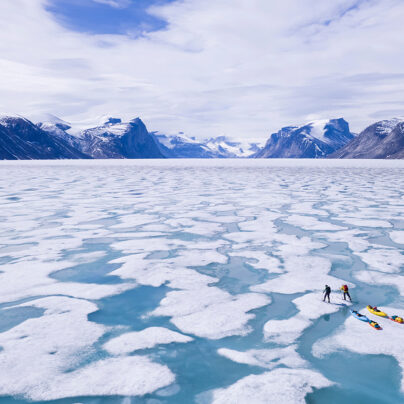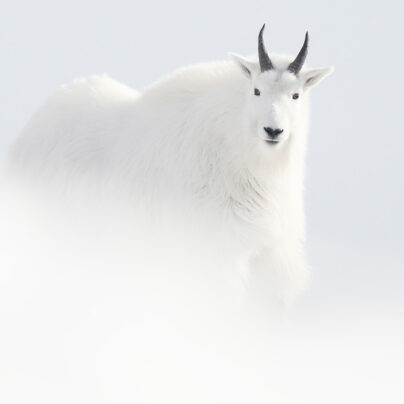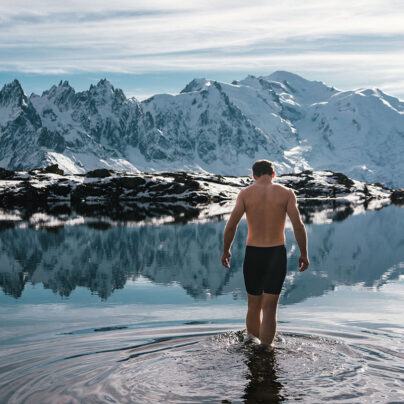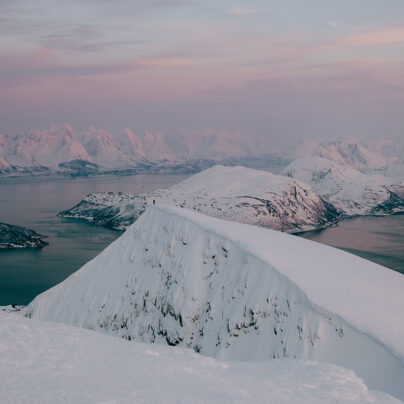Continuum
Wing Foiling Cape Horn
Words & Photography by Marko Magister
Outside it is already dark. The temperature has dropped below zero and it is snowing, but inside our two-masted sailing boat, the Ksar, it is warm and cosy. Every now and then a stronger gust shakes us – a reminder that we are very far from civilisation. As usual we are gathered around the stove, listening with fascination to the stories of Atilio, our captain.
‘Cape Horn, what a place! More than 800 ships have sunk there over the years. I have been there many times on the boat – I don’t even remember how many. When I was 19 years old I went kayaking with some friends. It took us a couple of days to make the journey, camping in the bays of the islands.’ He shows us an old and creased photograph. ‘Look, here we are on the beach that lies east of the Cape.’
We all crane in to see. Yago, I think, is even more attentive than the rest of us. ‘You look very young!’ he says. The captain smiles. ‘Yes, I am the youngest person to have rowed to Cape Horn and back. We had good conditions, otherwise it would have been impossible.’ And a light goes on in Yago’s eyes. ‘It would be great to wing foil there.’ The idea immediately captures my imagination, and I blurt out ‘Let’s go!’ almost immediately.
‘You have to be careful,’ Atilio cautions. ‘Cape Horn does not forgive your mistakes…’ But when Yago gets an idea in his head it is hard to convince him otherwise. ‘Come on, Captain!’
The captain smiles again. ‘If the weather allows it, why not?’
We are travelling with my friend Yago Lange, a former Olympic sailor who left the competition world to dedicate himself to caring for the oceans. He is a calm but highly motivated person with a clear objective: to promote a positive change in the relationship we have with nature. Today he is dedicated to foiling and sailing in remote places, and using the sport to raise awareness and spread an environmental message.
Captain Atilio deserves a separate chapter. A wise guy, with many years of experience navigating the waters of the South Atlantic Ocean. He inspires confidence and his word is not disputed. ‘Respect and affection’ is a phrase that he often repeats and sums up his personality well. Robust and affable, he’s exactly the kind of companion you want on an expedition like this one.





Part I: Peninsula Mitre – it’s always plan B in Patagonia
We sail through the Beagle Channel, cutting through a mysterious and wild land that is one of the few remaining untouched ecosystems on the planet. Curtains of rain move over the mountains and waves break against the cliffs. Low clouds engulf the coastline, occasionally dissipating to allow us glimpses of this raw nature. An albatross rides the storm with grace. This weather will make it difficult to achieve our goal: to sail our boat to the end of Peninsula Mitre and cross to Isla de los Estados on a wing foil.
Peninsula Mitre is as close to pristine as anywhere on Earth, and the most important carbon sink in Argentina. Located at the southernmost tip of the South American continent, it is home to intact kelp forests and one of the largest peatlands of South America – two ecosystems that play a key role in planetary climate stability. Giant kelp, abundant in the coastal waters of Peninsula Mitre, is a type of algae that, per square metre, captures 10 times more carbon than tropical forests. In the last half-century, almost half of the planet’s kelp forest has disappeared. Mitre is one of the last undisturbed refuges for this increasingly rare underwater ecosystem. Peatlands, meanwhile, are the largest terrestrial organic carbon sink on Earth. They store twice as much carbon as all the world’s forests.
Grassroots organisations have been working for more than three decades to protect Peninsula Mitre, but, incredibly, most Argentines do not know of the existence of this ecosystem – much less its importance. To be honest, I didn’t know much about it either.
The objective of our trip was not only to learn more about the area but also to contribute to its protection. As we have done in the past, Yago Lange and I want to wing foil in these waters and use the sport to spread a conservation message. Our goal is to bring visibility to this place and raise awareness about the importance of its protection.
In addition to Yago and Atilio, the team is made up of Marcela, one of the best kitesurfers in the world, and David, a member of PEM – one of the organisations that works for the protection of Peninsula Mitre.
The only way to get to Peninsula Mitre is by boat or on foot. We set sail from Ushuaia aboard the Ksar and, after two days of sailing, the coast seems to have no end. Bay after bay and mountain after mountain continue to appear before us. Sailing east through the Beagle Channel among humpback whales, dolphins, sea lions, and abundant bird life, I am surprised by the enormity of this place. It is the first of many things to surprise me.
The fact that the oxygen in two out of every three human breaths comes from the ocean takes another dimension here. Huge kelp forests extend along most of the bays, something that Yago and I have never seen before. Numerous humpback whales feed in the channel and we see their blows outlined clearly against the coastline.
But the weather worsens as we progress. Late in the afternoon we anchor in a huge bay called Bahia Aguirre. The cold is intense. Snow flurries whirl around the boat, and the wind is gusting, but Marcela and Yago begin to prepare their equipment. With this region’s unpredictable conditions, perhaps it will be the only opportunity to wing foil. We know that if the weather stays as forecast, we will have to turn around and go back to a safe port.
‘Be careful with the wing,’ Atilio says. ‘Don’t get it caught in the shrouds, it can get punctured!’ Inflating the wings and assembling the boards and foils on top of the boat is not an easy task, but after a bit of teamwork Marcela and Yago are flying across the bay. Turquoise sails contrast against a stormy background, and they look like two aliens riding a mystical landscape that is almost certainly witnessing this sport for the first time in history.
And suddenly, like so many other times, everything becomes familiar. Time seems to stop but at the same time it speeds past. The cold disappears and is replaced by that feeling of satisfaction, of knowing that we are achieving at least some of what we came to do.
Back on the boat, examining the meteorological charts, we have to make a decision. Bad weather is approaching fast. There is no more time to lose – we must go back. The Isla de los Estados will have to wait for another time.
Frustrated, but happy to have learnt at least a little about this beautiful place, we start the long navigation back to Ushuaia. In this part of the world weather and nature have the last word.





Part II: Chilean fjords – the beauty of the unexpected
Yago’s smile is mischievous. ‘What if we go to Cape Horn, Captain?’
‘With this weather? Impossible!’ But, seeing our disappointment, Atilio proposes that we extend our trip for another week and sail west to explore the fjords of Chile. Thanks to the large number of bays, it will be easier to find safer anchorage areas to protect ourselves from the storms.
Due to the time of year we find no-one else in the fjords, and the feeling of solitude is truly overwhelming. I am moved to silence by the majesty of this place: rock formations polished by ice over millions of years, waterfalls and hanging glaciers falling into the sea, forests without end shaped by storms. And, high above, the peaks of the Darwin Range twinkle down upon us, wrapped in their cloaks of snow and ice.
The landscape is impressive, but it hides a distressing reality. Atilio points to a hanging glacier. ‘The last time I came here was two years ago, before the pandemic. The ice reached to the sea then.’ He points to a different glacier, expression worried. ‘Do you see that this one is changing colour? It has separated from the main glacier that feeds it. It will disappear soon.’
The captain’s distress is sad to watch. Seeing this in person is not the same as hearing about it on TV. When I point my camera at these ice giants I feel a certain responsibility – as if I am recording a moment of history forever. The glaciers will never be the same as they are today. And some will probably disappear without anyone seeing them at all.
As we keep sailing, small pieces of ice begin to appear on the surface, first one, two, ten, until suddenly we are sailing in the middle of a surreal landscape. Up goes the drone. Through its camera we look like a tiny spaceship voyaging through the cosmos. The bangs and groans of ice hitting the Ksar’s steel hull are alien and disturbing, and I would be worried if not for the captain’s untroubled calm.
The winds are surprisingly low as we enter one of the fjords. With rock walls more than 500m high flanking us on both sides it looks like a sheltered place to anchor, but nature surprises us again. In less than five minutes the sea is transformed, wind-whipped water flying. ‘Hold on tight!’ the captain cries as our dinghy flies through the air and falls upside down. Even with all the sails furled, the ship is fully listing, struggling with the powerful gusts barrelling down the rocky slopes. Everything is out of control for a few minutes. Until, suddenly, it falls calm again. Another example of how unpredictable the weather can be in this corner of the planet.
We anchor off a wooded shoreline overlooking a huge glacier. Mindful of the unpredictable weather, Atilio commands us to secure the boat with lines to trees on the shore in addition to the anchor in the bow. Sure enough, in the middle of the night we are woken by another set of powerful gusts and the ship begins pulling on the ropes like a runaway horse. No-one can get any sleep until the wind decides that it has had its fun and everything returns to silence.
The next day Yago jumps back out of the boat into the icy waters of the Beagle Channel. This time conditions are ideal for foiling. The minute silhouette of his sail against the giant walls of ice and rock is a great representation of our insignificance in the middle of this enormous landscape.





Part III: Cape Horn – the end of the world
‘What do you think about going to Cape Horn?’ Yago asks for about the fifth time that day.
‘You’re going to insist until we go, right?’ Atilio says, laughing. ‘When we have comms and can download the weather again, we’ll analyse it, OK? We could skip returning to Ushuaia, stock up in Puerto Williams, and continue south. Don’t lose hope, Yago!’
The Cape lies at the northern end of the Drake Passage, one of the most dangerous seas in the world, and marks the place where the South Pacific and Atlantic Oceans meet.
On the weather chart we could see huge low-pressure systems advancing one after another through the Pacific towards the tip of the continent. The conditions that we needed for our plan are very rare at this time of the year.
Sometimes luck strikes. And as if nature had understood that our intentions were good, it gave us an amazing end to our trip. Conditions are ideal as the Ksar proceeds south. On the horizon, far to the east, we can make out the strange shapes of Isla de los Estados, and to the west the snow-capped peaks of Hoste Island. The sea that can be a real hell is calm as a lake.
As we raise anchor after a night in a beautiful bay on Herschel Island, the sky lights up with an endless palette of colour and a group of dolphins bursts through the surface around our boat. They stay with us as we leave the bay and begin to circle the island towards Cape Horn.
***
I stand on a pitching deck, trying not to let myself be intimidated by the power of the giant waves advancing through the Pacific and exploding against the islets and rocks around Isla Hornos. And, as Yago jumps into the water, these waves present a totally unexpected challenge. The valleys between them are both deep and windless – canyons of water mirroring the fjords we have travelled through on our long journey – and it takes longer than it should for the board to lift up from the surface and start to fly.
Another wave rolls in, hiding him from our view, and when we see him again he is sailing uphill to get past the next mountain of water. It is one of the most extraordinary things I have ever seen: the essence of sea and land melded into one dizzying, monumental continuum.
Gradually, perhaps because we are willing it to be so, the wind settles. Conditions for foiling improve. The sharp peaks crowning the cliffs of the Cape are illuminated by the sun that filters through the storm clouds, and once again nature prepares an incredible scenario for us. Yago’s board begins to fly. And he becomes the first person to wing foil at Cape Horn.
The sound of a cork popping. ‘A little champagne for Neptune, a little for the Ksar, and the rest for us.’ Atilio raises the bottle as Yago flies past us. ‘Salud!’
A pair of southern giant petrels fly close by and escort Yago as he passes in front of the cliffs again and again. After sailing for almost an hour, he gets back on the boat. The physical and mental preparation of the last months has paid off. In the previous days he he told me that he constantly visualised the moment of jumping into the icy waters of Cape Horn.
All voyages change you in some way. But in these expeditions, in which we try to learn more about our planet and do something to protect it, that change is much more profound. It was a big step forward in this process of learning to really connect with mother Earth. And looking back I notice something that has been repeated on every one of these trips. Many things do not go as planned – but many times nature and weather end up transforming our experiences into something even better than we had hoped for.
First published in Sidetracked Volume 26
In December 2022 the government of Tierra del Fuego approved a law to create the 1.2-million-acre Peninsula Mitre Natural Protected Area, protecting Argentina’s biggest carbon sink and setting the path for a more robust nature-based economy. Yago and Marko are working on a new expedition to Isla de los Estados.
Words and photography bu Markoo Magister // @markomagister
Featuring Yago Lange // @yagolange







